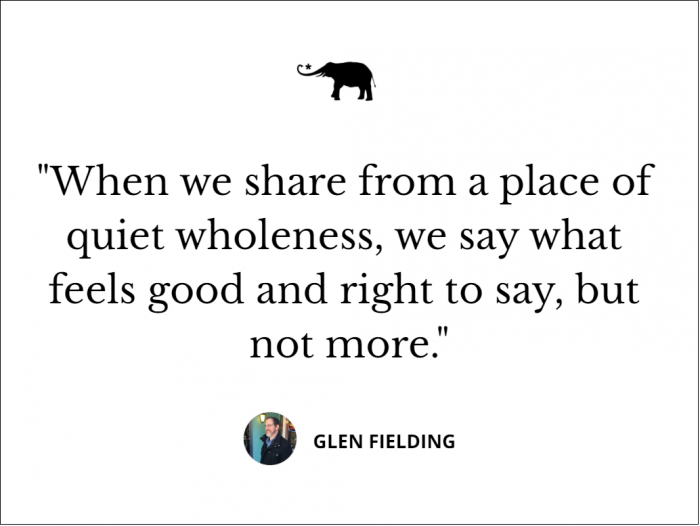~
At a recent gathering with friends, the warm, soulful sharing that I always looked forward to was punctuated with moments of pointed discomfort.
The discomfort followed a fellow member’s expression of concern for my well-being. As we each took turns offering an update on our lives, he asked me whether I was okay. I must have seemed mopey and withdrawn, and my friend noticed.
What was uncomfortable for me was not my friend’s inquiry. It was how I responded.
I took his question as an invitation to unload heavy emotional freight. I wasn’t really okay, and I wanted to be open and “authentic” about what was weighing me down.
But after three or four minutes, I caught myself. Going into detail about the disappointment and hurt in my week’s relational life didn’t feel right. It struck me less as authentic and more as indiscriminate. I was letting the social situation pull me out of alignment with my inner center of balance.
It wasn’t that I wanted to be closed or superficial. It was simply that I wanted to keep some things private.
Later, as I reflected on this episode and similar experiences I’ve had, it dawned on me that I’m able to see and sense when my oversharing tendency is arising. More importantly, I can take a few basic steps to prevent oversharing, to begin with.
Seeing and sensing when oversharing starts to happen
As I retrace the arc of my oversharing, I can spot visual and sensory signs that it’s happening or looming.
One sign involves my inner sight. When my visual self-image becomes hazy and indistinct, that’s a clue that I’ve lost my boundaries. In this experience, the picture I have of myself is a moving blur of a figure, one without a clear and firm shape. It’s as if I am a river of thoughts and feelings that is running over its banks, going everywhere and nowhere.
When I’m a haze to myself, my self-disclosure is more like a diffuse dispersion than a focused flow.
The other way I discover I’m oversharing is by being disconnected from my breath. When I don’t feel the rhythm of my breath, it’s a sign I’m losing touch with my own essential being. The steady regularity of breath, with its organic balancing of inhalation and exhalation, brings me home to my inherent steadiness. When I overshare, the harmony of the breath is outside my awareness, and its potential to center me is lost.
Preventative measures
As I anticipate entering the same friendship circle again in a couple of weeks, it strikes me that I might prepare myself more deliberately to share from a centered place.
In the present moment, I’m doing a kind of dress rehearsal for this preparation, trying out a few practices that might be especially beneficial when the time to gather is closer at hand.
Finding sight of myself
When I imagine sharing in my friend community, I notice, once again, that I can’t see the outer form of myself clearly.
But as I let myself settle into my body and my breath, a clearer and stronger image of myself comes to mind. It’s an image of myself swimming, something I’ve always loved to do from elementary school days to my 70th year.
Specifically, I see myself on a floating wooden platform in a roped-off area of water at my town’s beach in the summer when I was 11 or 12. I’m poised to do a racing dive for a swimming competition that the town’s parks and recreation department had organized. And then, I spring forward, glide onto the water’s surface, and swim with clear self-direction to the platform at the other end of the lane.
The effect of this visualization is palpable. I feel enlivened. My heart opens and lifts and the crown of my head rises. I smile as I let myself feel the pride of winning a gold medal that day. And my self-vision is sharp and clear.
A fear arises that “after the pride comes the fall,” and that the universe will punish me for allowing myself to believe in my clear and confident swimming self.
But the fear of jinxing myself rises, falls, and dissolves. I come back to the image and energy of my strong self.
This swimming meditation has enabled me to catch a glimpse of myself as a clearly defined yet open and agile person. With the swimming meditation as support, perhaps I’ll be able to trust that I can share without the risk of diving into the wrong lane or swimming outside the safety ropes.
Finding my breath
As I was doing my swimming meditation, I wanted not only to see the shape of myself. I also wanted to follow the sensations of my breath.
What I noticed is that as I imagined myself swimming with clarity and purpose, my breath seemed to glide with a pleasing lightness and lift through the central channel of my body, from the base of my spine up through the crown of my head. My breath lingered for a moment or two just behind my heart, soothing the space there with a gently pulsing rhythm.
As my breath traveled from heart to crown, it seemed to widen my inner channel and fortify my resolve. The resolve was not about winning the swimming race but about being as fully present with my body, with the water, and with the forward-crawl stoke I was using. The breath felt like not only the source of life but a singular sign of my aliveness.
Setting intentions
After my swimming and breath meditation, I thought further about meeting with my friends again.
What I wondered was whether it would be helpful to plan out what I wanted to say—and not say. Perhaps I should create a kind of script for myself.
But as I reflected further, the solution to oversharing didn’t seem to lie in planning or scripting. That would be a rigid overcorrection.
The alternative to planning needn’t be a rudderless outpouring of stories and feelings. The alternative was to set my intentions for sharing and then honor them in practice. These intentions would be to bring into the shared space an inner clarity and strength—an attunement to my breath and body, and a discerning (and not indiscriminate) openness.
Self-visualization, breath-sensitive meditation, and thoughtful intention-setting can help us to slow down, see what is important and appropriate to share, and communicate with integrity.
When we share from a place of quiet wholeness, we say what feels good and right to say, but not more.












Read 6 comments and reply